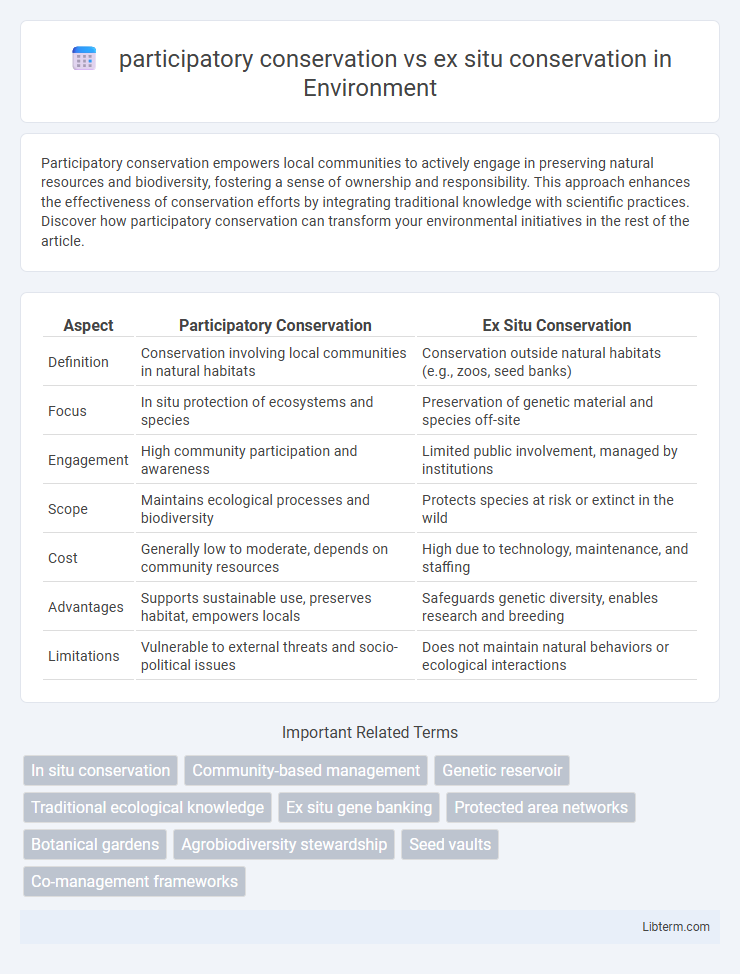Participatory conservation empowers local communities to actively engage in preserving natural resources and biodiversity, fostering a sense of ownership and responsibility. This approach enhances the effectiveness of conservation efforts by integrating traditional knowledge with scientific practices. Discover how participatory conservation can transform your environmental initiatives in the rest of the article.
Table of Comparison
| Aspect | Participatory Conservation | Ex Situ Conservation |
|---|---|---|
| Definition | Conservation involving local communities in natural habitats | Conservation outside natural habitats (e.g., zoos, seed banks) |
| Focus | In situ protection of ecosystems and species | Preservation of genetic material and species off-site |
| Engagement | High community participation and awareness | Limited public involvement, managed by institutions |
| Scope | Maintains ecological processes and biodiversity | Protects species at risk or extinct in the wild |
| Cost | Generally low to moderate, depends on community resources | High due to technology, maintenance, and staffing |
| Advantages | Supports sustainable use, preserves habitat, empowers locals | Safeguards genetic diversity, enables research and breeding |
| Limitations | Vulnerable to external threats and socio-political issues | Does not maintain natural behaviors or ecological interactions |
Introduction to Conservation Approaches
Participatory conservation engages local communities in protecting biodiversity through traditional knowledge and sustainable resource management, fostering long-term stewardship and ecological balance. Ex situ conservation involves preserving species outside their natural habitats, such as in seed banks, botanical gardens, or zoos, ensuring genetic diversity and safeguarding against extinction. Both approaches complement each other by combining in situ community involvement with controlled, scientific preservation methods for effective biodiversity conservation.
Defining Participatory Conservation
Participatory conservation involves engaging local communities in the management and protection of natural resources, emphasizing collaboration and indigenous knowledge to ensure sustainable outcomes. Unlike ex situ conservation, which focuses on preserving species outside their natural habitats such as in zoos or seed banks, participatory conservation promotes in situ strategies that maintain ecosystems intact. This approach enhances biodiversity conservation by integrating cultural values and empowering stakeholders directly affected by environmental changes.
Understanding Ex Situ Conservation
Ex situ conservation involves preserving species outside their natural habitats, typically in facilities such as botanical gardens, zoos, and seed banks, ensuring genetic diversity is maintained under controlled conditions. This approach safeguards endangered species from immediate threats like habitat destruction and climate change while enabling research, breeding programs, and potential reintroduction efforts. In contrast to participatory conservation, which actively involves local communities in habitat protection, ex situ conservation emphasizes scientific management and infrastructure to preserve biodiversity beyond natural ecosystems.
Key Principles of Participatory Conservation
Participatory conservation centers on community involvement, local knowledge integration, and empowerment of indigenous people to manage natural resources sustainably. It prioritizes collaborative decision-making, equitable benefit-sharing, and adaptive management of ecosystems within their cultural contexts. These key principles contrast with ex situ conservation, which focuses on preserving species outside their natural habitats, often in controlled environments like botanical gardens or seed banks.
Core Strategies in Ex Situ Conservation
Ex situ conservation focuses on preserving genetic diversity by maintaining plant and animal species outside their natural habitats, primarily through seed banks, botanical gardens, and captive breeding programs. Core strategies include collecting and storing germplasm, ensuring genetic integrity through controlled breeding, and facilitating reintroduction efforts to bolster wild populations. This method contrasts with participatory conservation, which emphasizes community involvement in on-site habitat management and sustainable resource use.
Community Involvement in Conservation Efforts
Participatory conservation emphasizes active community involvement in preserving local biodiversity, fostering stewardship through traditional knowledge and collective decision-making. Ex situ conservation, while crucial for protecting endangered species outside their natural habitats, often operates with limited direct community engagement. Integrating local communities in conservation strategies enhances long-term sustainability and cultural relevance of biodiversity protection initiatives.
Challenges and Limitations of Participatory Conservation
Participatory conservation faces challenges such as limited local capacity, conflicting community interests, and inadequate funding, which can hinder effective resource management. Social dynamics and power imbalances often restrict equitable participation, reducing the program's sustainability and impact. Unlike ex situ conservation that relies on controlled environments, participatory approaches struggle with maintaining long-term ecological balance amid external pressures.
Drawbacks and Risks of Ex Situ Conservation
Ex situ conservation faces significant drawbacks, including high costs and the potential loss of genetic diversity due to limited population sizes maintained outside natural habitats. This method risks disrupting ecological interactions and often fails to replicate natural selection pressures, leading to reduced adaptability when species are reintroduced. Furthermore, reliance on ex situ techniques may divert attention and resources from critical in situ conservation efforts essential for ecosystem sustainability.
Integrating Participatory and Ex Situ Methods
Integrating participatory conservation with ex situ conservation enhances biodiversity preservation by combining community knowledge and genetic resource safeguarding. Participatory conservation engages local stakeholders in habitat management, ensuring sustainable use and cultural relevance. Ex situ methods, such as seed banks and botanical gardens, provide controlled environments for species recovery, complementing in situ efforts with genetic diversity preservation and research opportunities.
Future Perspectives in Biodiversity Conservation
Participatory conservation enhances future biodiversity preservation by involving local communities in habitat management, ensuring sustainable use of resources, and fostering ecological stewardship through traditional knowledge integration. Ex situ conservation complements these efforts by safeguarding genetic diversity outside natural habitats through seed banks, botanical gardens, and captive breeding programs, enabling species survival under climate change stressors. Combining both approaches creates resilient conservation strategies that address habitat loss, genetic erosion, and promote adaptive capacity for ecosystem restoration.
participatory conservation Infographic

 libterm.com
libterm.com